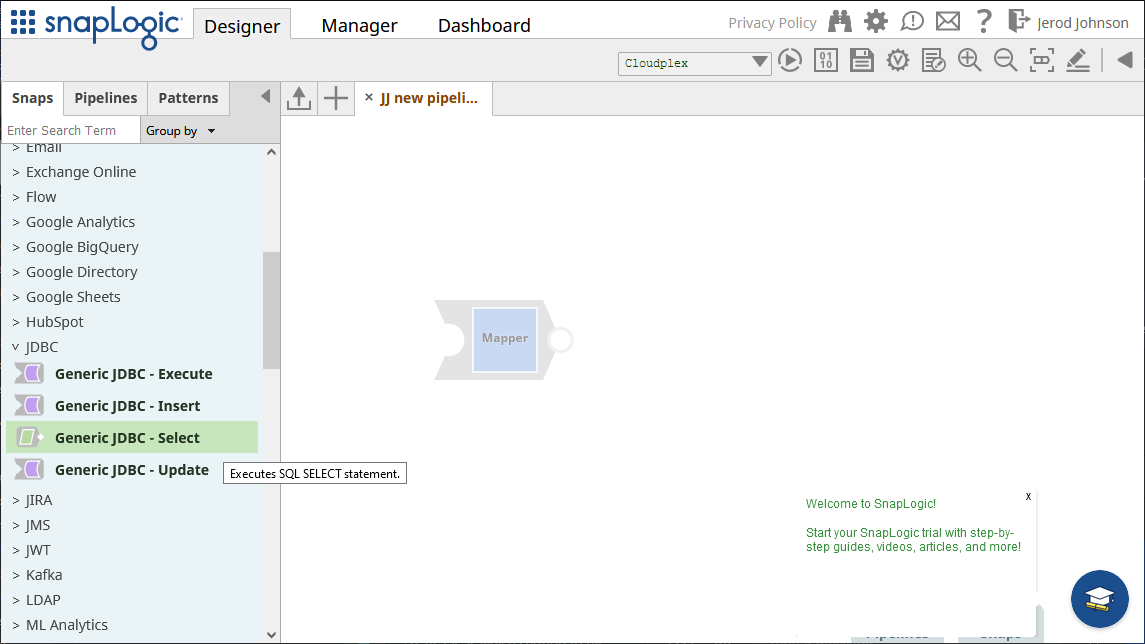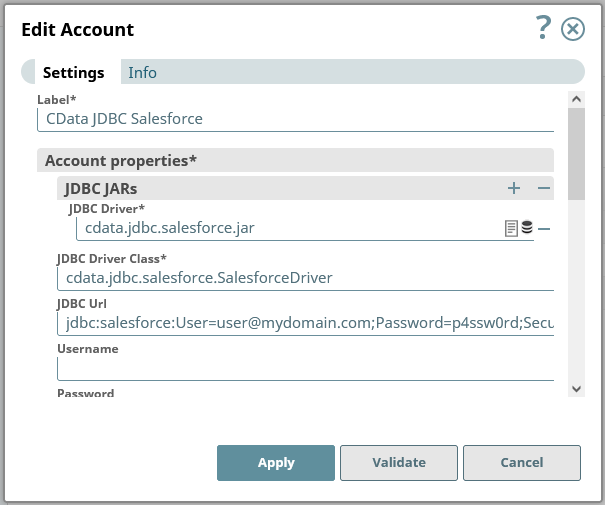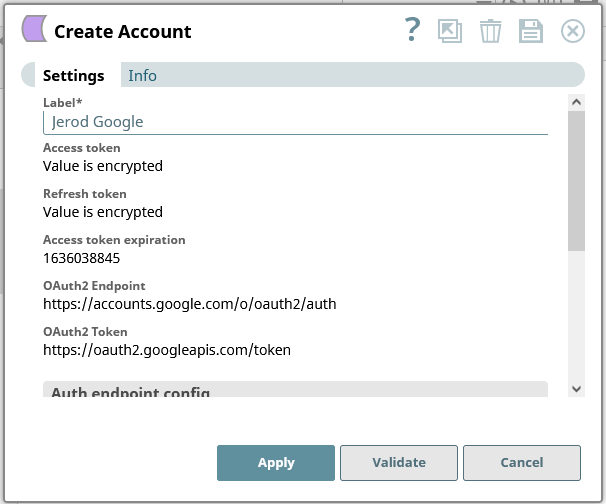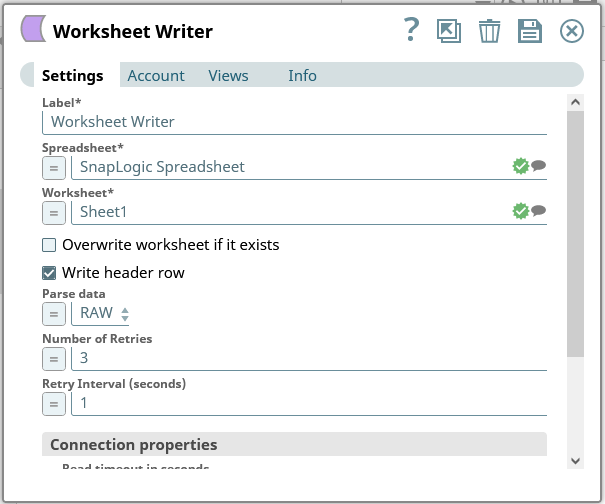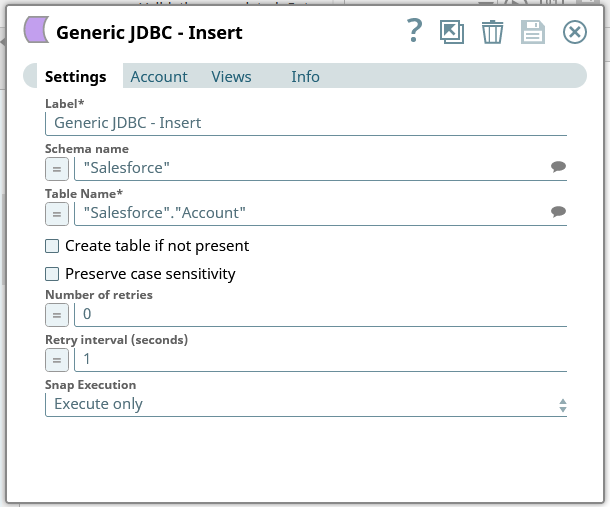Discover how a bimodal integration strategy can address the major data management challenges facing your organization today.
Get the Report →Integrate Amazon Athena with External Services using SnapLogic
Use CData JDBC drivers in SnapLogic to integrate Amazon Athena with External Services.
SnapLogic is an integration platform-as-a-service (iPaaS) that allows users to create data integration flows with no code. When paired with the CData JDBC Drivers, users get access to live data from more than 250+ SaaS, Big Data and NoSQL sources, including Amazon Athena, in their SnapLogic workflows.
With built-in optimized data processing, the CData JDBC Driver offers unmatched performance for interacting with live Amazon Athena data. When platforms issue complex SQL queries to Amazon Athena, the driver pushes supported SQL operations, like filters and aggregations, directly to Amazon Athena and utilizes the embedded SQL engine to process unsupported operations client-side (often SQL functions and JOIN operations). Its built-in dynamic metadata querying lets you work with Amazon Athena data using native data types.
Connect to Amazon Athena in SnapLogic
To connect to Amazon Athena data in SnapLogic, download and install the CData Amazon Athena JDBC Driver. Follow the installation dialog. When the installation is complete, the JAR file can be found in the installation directory (C:/Program Files/CData/CData JDBC Driver for Amazon Athena/lib by default).
Upload the Amazon Athena JDBC Driver
After installation, upload the JDBC JAR file to a location in SnapLogic (for example, projects/Jerod Johnson) from the Manager tab.
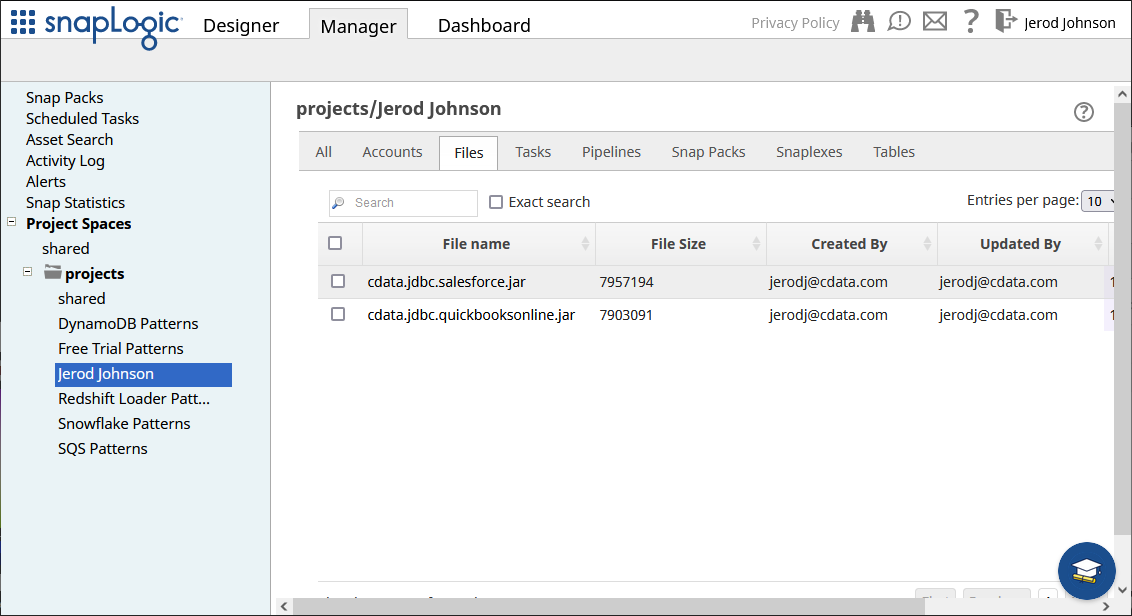
Configure the Connection
Once the JDBC Driver is uploaded, we can create the connection to Amazon Athena.
- Navigate to the Designer tab
- Expand "JDBC" from Snaps and drag a "Generic JDBC - Select" snap onto the designer
![Adding a Generic JDBC snap onto the designer]()
- Click Add Account (or select an existing one) and click "Continue"
- In the next form, configure the JDBC connection properties:
- Under JDBC JARs, add the JAR file we previously uploaded
- Set JDBC Driver Class to cdata.jdbc.amazonathena.AmazonAthenaDriver
Set JDBC URL to a JDBC connection string for the Amazon Athena JDBC Driver, for example:
jdbc:amazonathena:AccessKey='a123';SecretKey='s123';Region='IRELAND';Database='sampledb';S3StagingDirectory='s3://bucket/staging/';RTK=XXXXXX;
NOTE: RTK is a trial or full key. Contact our Support team for more information.
![Configuring a connection (Salesforce is shown)]()
Built-In Connection String Designer
For assistance in constructing the JDBC URL, use the connection string designer built into the Amazon Athena JDBC Driver. Either double-click the JAR file or execute the jar file from the command-line.
java -jar cdata.jdbc.amazonathena.jar
Fill in the connection properties and copy the connection string to the clipboard.
Authenticating to Amazon Athena
To authorize Amazon Athena requests, provide the credentials for an administrator account or for an IAM user with custom permissions: Set AccessKey to the access key Id. Set SecretKey to the secret access key.
Note: Though you can connect as the AWS account administrator, it is recommended to use IAM user credentials to access AWS services.
Obtaining the Access Key
To obtain the credentials for an IAM user, follow the steps below:
- Sign into the IAM console.
- In the navigation pane, select Users.
- To create or manage the access keys for a user, select the user and then select the Security Credentials tab.
To obtain the credentials for your AWS root account, follow the steps below:
- Sign into the AWS Management console with the credentials for your root account.
- Select your account name or number and select My Security Credentials in the menu that is displayed.
- Click Continue to Security Credentials and expand the Access Keys section to manage or create root account access keys.
Authenticating from an EC2 Instance
If you are using the CData Data Provider for Amazon Athena 2018 from an EC2 Instance and have an IAM Role assigned to the instance, you can use the IAM Role to authenticate. To do so, set UseEC2Roles to true and leave AccessKey and SecretKey empty. The CData Data Provider for Amazon Athena 2018 will automatically obtain your IAM Role credentials and authenticate with them.
Authenticating as an AWS Role
In many situations it may be preferable to use an IAM role for authentication instead of the direct security credentials of an AWS root user. An AWS role may be used instead by specifying the RoleARN. This will cause the CData Data Provider for Amazon Athena 2018 to attempt to retrieve credentials for the specified role. If you are connecting to AWS (instead of already being connected such as on an EC2 instance), you must additionally specify the AccessKey and SecretKey of an IAM user to assume the role for. Roles may not be used when specifying the AccessKey and SecretKey of an AWS root user.
Authenticating with MFA
For users and roles that require Multi-factor Authentication, specify the MFASerialNumber and MFAToken connection properties. This will cause the CData Data Provider for Amazon Athena 2018 to submit the MFA credentials in a request to retrieve temporary authentication credentials. Note that the duration of the temporary credentials may be controlled via the TemporaryTokenDuration (default 3600 seconds).
Connecting to Amazon Athena
In addition to the AccessKey and SecretKey properties, specify Database, S3StagingDirectory and Region. Set Region to the region where your Amazon Athena data is hosted. Set S3StagingDirectory to a folder in S3 where you would like to store the results of queries.
If Database is not set in the connection, the data provider connects to the default database set in Amazon Athena.
![Using the built-in connection string designer to generate a JDBC URL (Salesforce is shown.)]()
- After entering the connection properties, click "Validate" and "Apply"
Read Amazon Athena Data
In the form that opens after validating and applying the connection, configure your query.
- Set Schema name to "AmazonAthena"
- Set Table name to a table for Amazon Athena using the schema name, for example: "AmazonAthena"."Customers" (use the drop-down to see the full list of available tables)
- Add Output fields for each item you wish to work with from the table
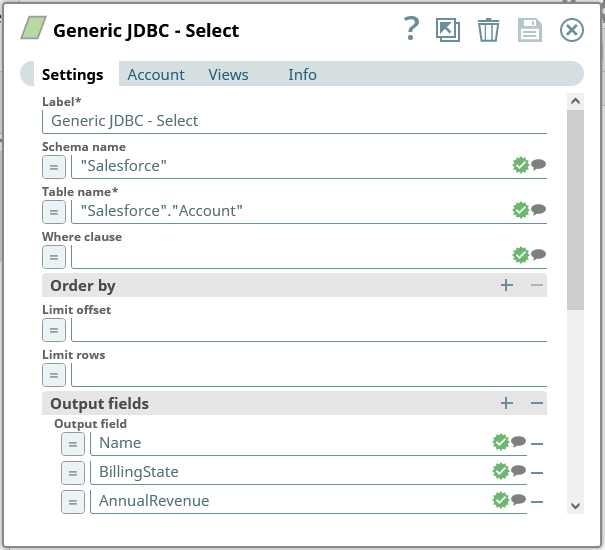
Save the Generic JDBC - Select snap.
With connection and query configured, click the end of the snap to preview the data (highlighted below).
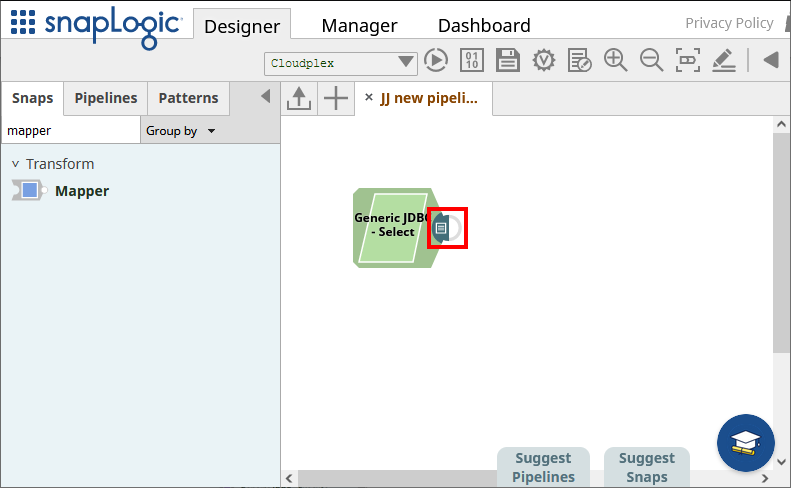
Once you confirm the results are what you expect, you can add additional snaps to funnel your Amazon Athena data to another endpoint.
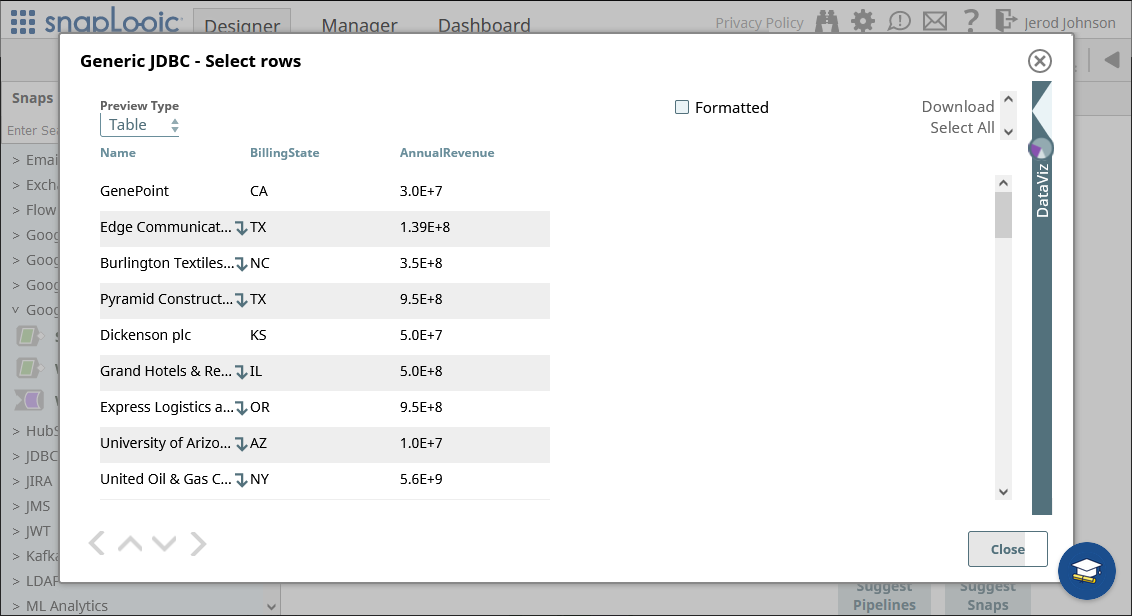
Piping Amazon Athena Data to External Services
For this article, we will load data in a Google Spreadsheet. You can use any of the supported snaps, or even use a Generic JDBC snap with another CData JDBC Driver, to move data into an external service.
- Start by dropping a "Worksheet Writer" snap onto the end of the "Generic JDBC - Select" snap.
- Add an account to connect to Google Sheets
![Connecting to Google]()
- Configure the Worksheet Writer snap to write your Amazon Athena data to a Google Spreadsheet
![Writing to a Google Spreadsheet]()
You can now execute the fully configured pipeline to extract data from Amazon Athena and push it into a Google Spreadsheet.
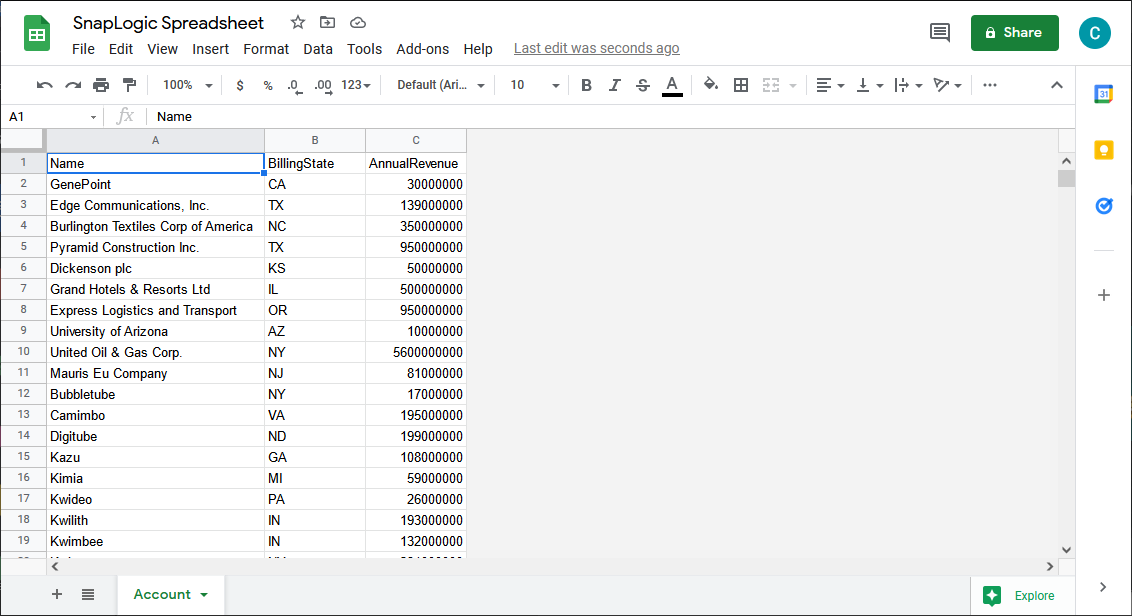
Piping External Data to Amazon Athena
As mentioned above, you can also use the JDBC Driver for Amazon Athena in SnapLogic to write data to Amazon Athena. Start by adding a Generic JDBC - Insert or Generic JDBC - Update snap to the dashboard.
- Select the existing "Account" (connection) or create a new one
- Configure the query:
- Set Schema name to "AmazonAthena"
- Set Table name to a table for Amazon Athena using the schema name, for example: "AmazonAthena"."Customers" (use the drop-down to see the full list of available tables)
![Configuring a INSERT snap (Salesforce is shown)]()
- Save the Generic JDBC - Insert/Update snap
At this point, you have configured a snap to write data to Amazon Athena, inserting new records or updating existing ones.
More Information & Free Trial
Using the CData JDBC Driver for Amazon Athena you can create a pipeline in SnapLogic for integrating Amazon Athena data with external services. For more information about connecting to Amazon Athena, check at our CData JDBC Driver for Amazon Athena page. Download a free, 30 day trial of the CData JDBC Driver for Amazon Athena and get started today.






